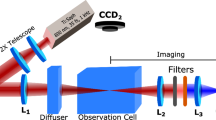Abstract
We are utilizing recent advances in ultrafast laser technology and recent discoveries in optimal shaping of laser pulses to significantly enhance the stand-off detection of explosives via control of molecular processes at the quantum level. Optimal dynamic detection of explosives is a method whereby the selectivity and sensitivity of any of a number of nonlinear spectroscopic methods are enhanced using optimal shaping of ultrafast laser pulses. We have recently investigated the Gerchberg–Saxton algorithm as a method to very quickly estimate the optimal spectral phase for a given analyte from its spontaneous Raman spectrum and the ultrafast laser pulse spectrum. Results for obtaining selective coherent anti-Stokes Raman spectra (CARS) for an analyte in a mixture, while suppressing the CARS signals from the other mixture components, are compared for the Gerchberg–Saxton method versus previously obtained results from closed-loop machine-learning optimization using evolutionary strategies.

Photo of an acousto-optic modulator based pulse shaper, with red lines denoting the laser beam path. Entering at the bottom left is the transform limited pulse (spectrogram inset shows wavelength versus time in a false color plot), and exiting at the bottom right is the the arbitrarily shaped pulse






Similar content being viewed by others
References
Moore DS (2004) Instrumentation for trace detection of high explosives. Rev Sci Instr 75:2499–2512
Moore DS (2007) Recent advances in trace explosives detection instrumentation. Sens Imaging 8:9–38
Moore DS, Goodpaster JV (2009) Explosives analysis. Anal Bioanal Chem 395:245–246
Moore DS, Rabitz H, McGrane SD, Greenfield M, Scharff RJ, Beltrani V, Roslund J (2009) Optimal dynamic detection of explosives. SPIE Proceed 7304:730413
Moore DS (2009) Optimal coherent control of sensitivity and selectivity in spectrochemical analysis. Anal Bioanal Chem 393:51–56
Chakrabarti R, Rabitz H (2007) Quantum control landscapes. Int Rev Phys Chem 26:671–735
Rabitz H (2004) Controlling quantum phenomena: why does it appear easy to achieve. J Modern Optics 51:2469–2475
Weiner AM (2000) Femtosecond pulse shaping using spatial light modulators. Rev Sci Instr 71:1929–1960
Dugan MA, Tull JX, Warren WS (1997) High-resolution acousto-optic shaping of unamplified and amplified femtosecond laser pulses. J Opt Soc Am B 14:2348–2358
Judson RS, Rabitz H (1992) Teaching lasers to control molecules. Phys Rev Lett 68:1500–1503
Nuernberger P, Vogt G, Brixner T, Gerber G (2007) Femtosecond quantum control of molecular dynamics in the condensed phase. Phys Chem Chem Phys 9:2470–2497
McGrane SD, Scharff RJ, Greenfield M, Moore DS (2009) Coherent control of multiple vibrational excitations for optimal detection. New J Physics 11:105047
Roth M, Guyon L, Roslund J, Boutou V, Courvoisier F, Wolf JP, Rabitz H (2009) Quantum control of tightly competitive product channels. Phys Rev Lett 102:253001
Katz O, Natan A, Silberberg Y, Rosenwaks S (2008) Standoff detection of trace amounts of solids by nonlinear Raman spectroscopy using shaped femtosecond pulses. Appl Phys Lett 92:171116
Li H, Harris A, Xu BW, Wrzesinski PJ, Lozovoy VV, Dantus M (2008) Coherent mode-selective Raman excitation towards standoff detection. Optics Express 16:5499–5504
Roslund J, Shir OM, Bäck T, Rabitz H (2009) Accelerated optimization and automated discovery with covariance matrix adaptation for experimental quantum control. Phys Rev A 80:043415
Rundquist A, Efimov A, Reitze DH (2002) Pulse shaping with the Gerchberg–Saxton algorithm. J Opt Soc Am B 19:2468–2478
Gerchberg RW, Saxton WO (1972) A practical algorithm for the determination of the phase from image and diffraction plane pictures. Optik 35:237
Urbanek DC, Berg MA (2007) Simultaneous time and frequency detection in femtosecond coherent Raman spectroscopy. I. Theory and model calculations. J Chem Phys 127:044306
Dhar L, Rogers JA, Nelson KA (1994) Time-resolved vibrational spectroscopy in the impulsive limit. Chem Rev 94:157–193
Gallmann L, Pfeifer T, Nagel PM, Abel MJ, Neumark DM, Leone SR (2007) Comparison of the filamentation and the hollow-core fiber characteristics for pulse compression into the few-cycle regime. Appl Phys B 86:561–566
Hauri D, Guandalini A, Eckle P, Kornelis W, Biegert J, Keller U (2005) Generation of intense few-cycle laser pulses through filamentation–parameter dependence. Optics Express 13:7541–7547
Lozovoy VV, Pastirk I, Dantus M (2004) Multiphoton intrapulse inteference 4. Characterization and compensation of the spectral phase of ultrashort laser pulses. Optics Lett 29:775
Trebino R, DeLong KW, Fittinghoff DN, Sweetser JN, Krumbügel MA, Richman BA, Kane DJ (1997) Measuring ultrashort laser pulses in the time–frequency domain using frequency-resolved optical gating. Rev Sci Instr 68:3277
Shirley JA, Hall RJ, Eckbreth AC (1980) Folded BOXCARS for rotational Raman studies. Optics Lett 5:380–382
Acknowledgments
The authors gratefully acknowledge the support of the US Department of Homeland Security. Los Alamos National Laboratory is an affirmative action equal opportunity employer operated by Los Alamos National Security, LLC for the National Nuclear Security Administration of the US Department of Energy under contract DE-AC52-06NA25396.
Author information
Authors and Affiliations
Corresponding author
Additional information
Published in the 10th Anniversary Issue.
Rights and permissions
About this article
Cite this article
Moore, D.S., McGrane, S.D., Greenfield, M.T. et al. Use of the Gerchberg–Saxton algorithm in optimal coherent anti-Stokes Raman spectroscopy. Anal Bioanal Chem 402, 423–428 (2012). https://doi.org/10.1007/s00216-011-5348-x
Received:
Revised:
Accepted:
Published:
Issue Date:
DOI: https://doi.org/10.1007/s00216-011-5348-x




